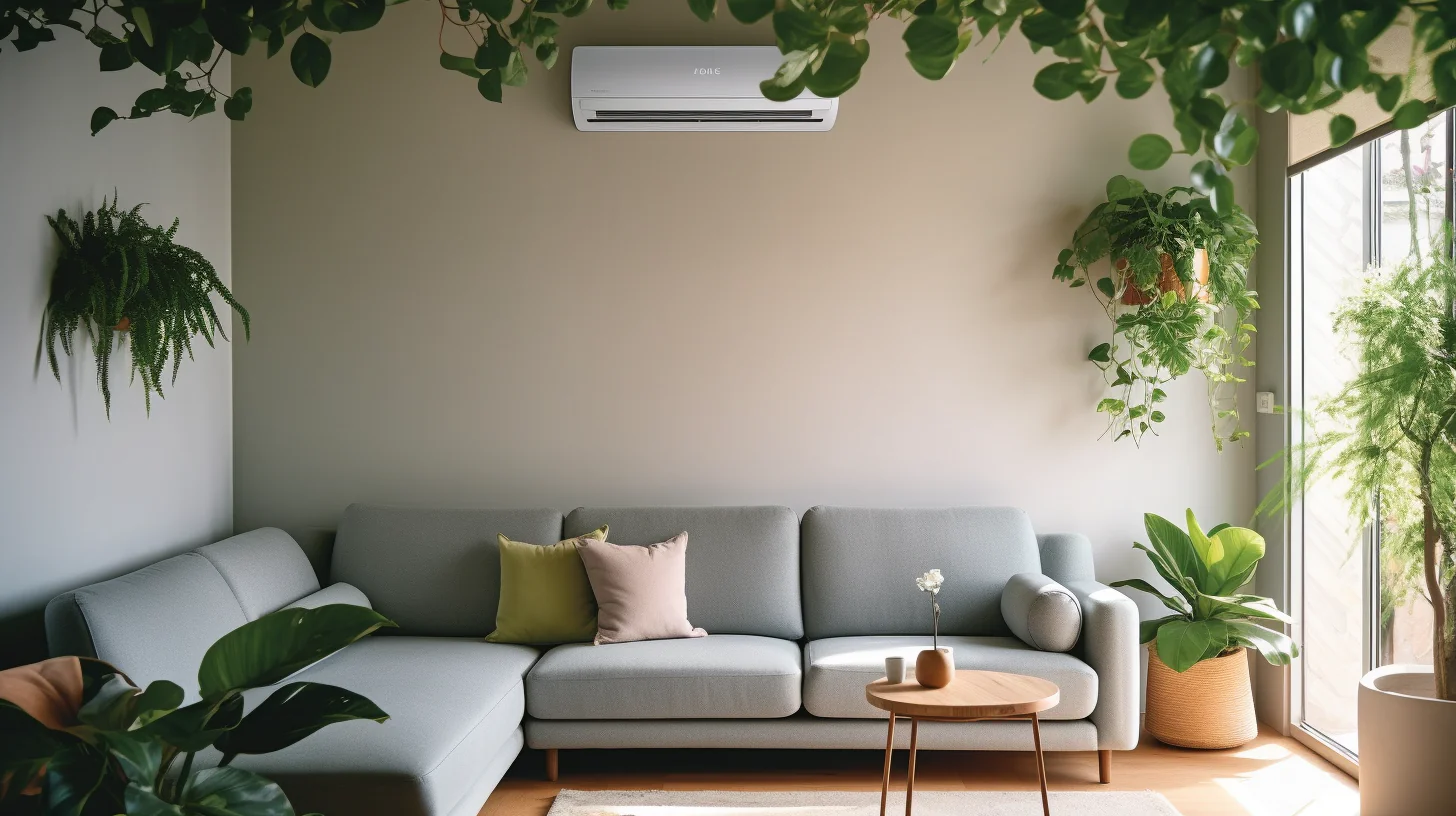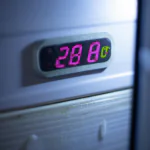Many of us love to travel, especially during summer breaks and holidays. However, leaving our homes unattended for an extended period can be a big concern, especially regarding energy efficiency and budget. One crucial factor to consider is setting the right air conditioning (AC) temperature when away from home.
According to a study conducted by the Florida Solar Energy Center, the optimum temperature to set your air conditioner when away from home is around 80 to 85 degrees Fahrenheit. This temperature range is high enough to save energy and keep your furniture and belongings safe from damage but not too high to create other problems.
Setting your AC at a lower temperature than recommended can cause furniture damage, discoloration, and unpleasant, musty smells. Mold and mildew can also begin to form in your home. On the other hand, an extremely high indoor temperature can increase humidity levels and create an environment that encourages the growth of mold and mildew.
A programmable thermostat is a useful tool that can help adjust the indoor temperature to fit your lifestyle or home use. Some of them can even be controlled remotely from a smartphone, making it easier to manage your energy consumption when you’re away.
Table of Contents
Ideal Temperature for AC When Away for Comfort and Energy Savings
When it comes to air conditioning, finding the right balance between comfort and energy efficiency is crucial. The Department of Energy suggests setting the thermostat at 78°F when people are at home and need cooling to balance energy savings and comfort. However, determining the best temperature for AC in your home will require experimentation with different settings and considering factors such as the number of people, amount of physical activity, humidity, amount of direct sunlight, and number of windows.
When you are away from home, setting the thermostat several degrees higher than normal, by about 7-10 degrees, is recommended to decrease energy costs. A programmable or smart thermostat can simplify this process by automatically adjusting the temperature according to your schedule. This way, you can enjoy a comfortable temperature when you return home while also making energy savings.
To save money and enhance comfort, consider the following:
- Turning on ceiling fans
- Closing window coverings during the day to reduce heat from sunlight
- Adding weather stripping to window and door openings
- Avoiding using heat-generating appliances during the day
- Performing regular maintenance on your air conditioner
It is also important to note that the optimal temperature for sleeping is between 60⁰ and 67⁰ F, regardless of the season outside. Infants and small children should be in rooms with slightly higher temperatures to ensure better, more restful sleep.
By finding the ideal temperature for your AC and taking steps to increase energy efficiency, you can stay comfortable and save money on your energy bills.
Factors to Consider When Setting AC Temperature When Away
If you plan to go on vacation or leave your home for an extended period, you may wonder what temperature to set the air conditioner. Some homeowners believe that turning off the AC while away can save energy and reduce bills, but this can cause more harm than good.
Leaving the air conditioning system on at a consistent temperature while away is more energy-efficient and helps prevent damage from excess humidity. High humidity levels in your home can cause furniture, walls, and flooring to warp or rot, leading to expensive repairs. By maintaining a consistent temperature, you can reduce humidity levels and keep your home protected.
But what temperature is ideal while away on vacation? Experts recommend setting the thermostat between 80 and 85 degrees Fahrenheit. This range is optimal for reducing energy consumption while keeping your home comfortable and protecting your belongings. Remember that the ideal temperature may vary depending on your climate, home insulation, and personal preferences.
To make setting the temperature for the home while away even easier, consider installing a programmable thermostat. These devices allow you to set a specific temperature schedule, so the AC can turn on and off according to when you are home or away. Additionally, many programmable thermostats can be managed conveniently from a smartphone, providing even greater control and flexibility.
- Leaving the AC on at a consistent temperature can prevent damage caused by excess humidity.
- An ideal temperature range while away from home is between 80 and 85 degrees Fahrenheit.
- The ideal temperature may vary depending on climate, home insulation, and personal preferences.
- A programmable thermostat can make setting the temperature while away even easier and can be managed conveniently from a smartphone.
Discuss the benefits and potential drawbacks of adjusting the AC temperature when leaving home
Adjusting the AC temperature when leaving home is a common practice. However, it can have both advantages and disadvantages. The main benefit of turning off the air conditioner is saving energy and money while away. On the other hand, it can be challenging to maintain a comfortable temperature in your home once you return if you turn off the AC.
Another advantage of turning off your AC when leaving home is that it can prevent potential damage from a broken air conditioner. If you’re going away for a while and the AC unit malfunctions, turning the system off completely can prevent further damage to the system while you’re away. However, this can lead to a scorching hot home upon your return.
One of the main disadvantages of turning off the air conditioner is that it can negatively affect your home environment. For instance, a shut-up house can quickly become hot, which can cause food in your pantry to spoil faster. Additionally, your pets could feel uncomfortable in an overly hot or humid home, making them ill. Furthermore, a house without circulating air can become extremely humid, leading to problems with mold, mildew, insects, and warping wood.
- Advantages:
- Saves energy and money while you’re away
- Prevents potential damage from a broken air conditioner
- Disadvantages:
- Hot, humid homes can cause problems with mold and mildew, spoil food faster, and make pets feel uncomfortable
- It can take a lot of energy to cool the house down once you return, which can negate the energy savings achieved from turning off the AC
While turning off the air conditioner when leaving home can be an effective way to save energy and money, it may do more harm than good. Ultimately, deciding which approach feels best for you and your family is up to you.
Recommended AC Temperature Settings When Away for Different Situations
Are you leaving your house for a short-term or long-term period? Or do you have pets that stay at home while you’re away? Setting your AC to the proper temperature is essential, as extreme temperatures can damage your home and affect your pets’ well-being. Here is a guide on recommended AC temperature settings:
- Switching off your AC entirely is not recommended if you’re going on vacation. High temperatures can damage valuables in your home, cause wood and concrete to crack and make food in the cupboard degenerate much faster. Additionally, your refrigerator will work harder in extreme heat, consuming substantial energy. Therefore, turning your thermostat to around 80 to 82 degrees Fahrenheit is best.
- The ideal temperature setting may vary depending on how long you will be away, the weather, and if you have pets. For example, if you are away for a week or more, you may require a dehumidifier to improve the performance of your AC and enhance your comfort when levels are over 60% in Texas.
- The ideal temperature settings for pets may vary depending on the animal’s physiology. Dogs regulate body temperatures through panting; for most dogs, the temperature shouldn’t be over 80 degrees. Cats and birds have smaller bodies that lose heat much faster and can tolerate warm interior air better than dogs. The recommended thermostat settings for cats and birds are between 70 and 85 degrees Fahrenheit.
- A smart thermostat can help maintain interior temperatures and avoid overworking the AC. Smart devices can also incorporate weather data to balance air conditioning and energy consumption. Some systems have a vacation mode, making configuring your cooling systems more convenient. With Wi-Fi capabilities, you can check the configurations to determine whether the conditions suit your pet.
Remember, proper temperature settings can help protect your home and pets. Additionally, tuning up your air conditioning unit at least once a year can maximize energy savings. Ideally, this should be done in spring before the warm season begins, especially if you live in Irving, where temperatures can get scorching hot.
How Smart Thermostats Help Manage AC Temperature When Away
If you’re looking for a seamless and efficient way to control your home’s temperature, smart thermostats are your answer. They offer many advantages that traditional thermostats don’t, such as remote access via a smartphone app, voice control, learning your preferred settings over time, and more. But one of the most significant benefits of smart thermostats is managing your AC temperature when you’re away.
In the past, many people would turn off their air conditioning completely when they left their homes for an extended period. This method would require a lot of energy to cool the house down when they returned, often leading to a less comfortable atmosphere for the occupants. However, you can activate a vacation mode that sets your temperature with a smart thermostat. This mode will make the temperature warmer but still turn on the AC unit based on the time you’ve fixed, ensuring that your house remains comfortable and that your energy bills do not rise.
- But that’s not all:
- Smart thermostats use motion sensors to identify when you are out of the house. Based on that, the thermostat will make “smart” temperature adjustments. This feature can help you reduce energy consumption and save money on your monthly bills.
- According to the US Department of Energy, increasing your thermostat’s temperature by 7-10 degrees Fahrenheit for eight hours or more during the day can reduce your energy consumption by up to 10%.
Smart thermostats are an excellent investment in your home’s energy management and your wallet’s health. They enable you to control your home’s temperature remotely, learn your preferences over time, and manage your AC usage properly when you’re not around. With their features and advantages, it’s clear that switching to a smart thermostat is a smart move.
Energy-Saving Tips for Using AC When Away
If you’re like most people, you want to come home to a cool and comfortable house after being away for a while. But did you know that adjusting your thermostat settings and sealing air leaks can reduce your energy consumption and save money on your energy bill? Here are some energy-saving tips that you can follow to ensure that your AC is functioning smartly and efficiently even when you’re not at home.
- Keep your house warmer than normal when you’re away: Heating and cooling your house accounts for almost 50% of your energy bill, so it’s best to keep your thermostat set to a higher temperature when you’re not at home. You can set a programmable thermostat to do this automatically based on your schedule without sacrificing your comfort.
- Avoid setting your thermostat too low: Setting your thermostat too low will not cool your home any faster and could actually lead to excessive cooling and unnecessary expenses. Instead, set your thermostat to a comfortable temperature based on the time of day, your activities, and your preferences.
- Seal cracks and openings: To prevent warm air from leaking into your home, inspect your doors, windows, and walls for leaks. Use caulk or weatherstripping to seal any openings that you find.
By following these simple energy-saving practices, you can reduce your energy consumption, save money on your energy bill, and help protect the environment. Remember, the key is to maintain a comfortable temperature while at home and raise the thermostat setting while you’re away from home. Stay tuned for more tips and insights on saving energy.
Debunk common misconceptions related to AC temperature settings when away
If you’re wondering about the best way to conserve energy when you’re not home, you might have encountered some common misconceptions. One of them is that turning off the AC when you’re away is the best way to save energy. However, this is a myth. It is better to turn up the thermostat instead of completely turning off the AC. Energy Star recommends keeping your home at 78 degrees when you’re home. This way, you can save money and stay comfortable without making your home susceptible to mold and pests.
Another myth you might have heard is closing vents in unused rooms to save energy. This, too, is a misconception. In reality, closing vents in rooms you do not use throws off the air distribution throughout your home. Doing so can cause pressure to build up in your ducts, making your air conditioning unit work harder than it should. This can end up wasting more energy than simply operating your system normally does, according to SaveOnEnergy.
Finally, you might think that keeping the ceiling fan on can help reduce the need for the AC to run. However, this is yet another myth. Fans move air in a room but do not affect the air temperature. Instead, they create a wind-chill effect that can make you feel cooler, making it an excellent solution when you want to cool down without lowering the thermostat.
- Myth: Turning off the AC when you’re not home will save energy
- Myth: Close vents in unused rooms
- Myth: Your air conditioner won’t have to run as much if you keep the ceiling fan turned on
Now that we’ve debunked some common misconceptions about AC temperature settings, you can confidently adjust your thermostat, knowing you’re doing it the right way. Stay tuned for more tips and information on achieving a comfortable home while saving energy.




